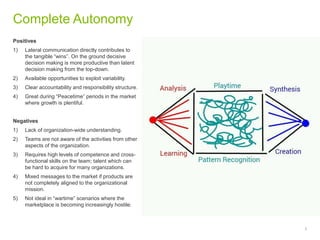DecentralizedControl_Linkedin
- 1. Decentralizing Control 1 For Product Development Ahmad Iqbal April 10, 2016
- 2. Decentralized Control Traditional Waterfall Behaviour: Centralized layers of control; PMO, Sr. Managers. Reason: 1. Spread the fixed costs most effectively and reach economies of scale. 2. System-level optimization. 3. More complete information for better decision making. Outcome: Slower decision making, greater latency in the process, and an increased cost of delay. A centralized office can only handle so much WIP, and likely follows a FIFO inventory management process. This also hides any urgent work items from getting surfaced, which again, compounds the increased cost of delay from products getting to market slower. 2 The Economic Role of JIT Information in Product Development 1) Decentralized, and autonomous teams have the freedom to make faster decisions and reduce cost of delay. 2) Enables faster feedback ŌĆō which has itŌĆÖs own economic benefit as seen in earlier ŌĆ£creating asymmetric payoff curvesŌĆØ. 3) By allowing autonomous teams to collaborate and make time- boxed decisions just in time, we cut productŌĆÖs time to market. 4) By making the best decision we can, using the information we have within our time-box period, we keep the development flowing, and will likely still choose the best possible path. In the case we made the wrong decision due to missing information, we can quickly change direction, and any cost of this change will likely not outweigh the benefits of accelerated delivery.
- 3. Complete Autonomy 3 Positives 1) Lateral communication directly contributes to the tangible ŌĆ£winsŌĆØ. On the ground decisive decision making is more productive than latent decision making from the top-down. 2) Available opportunities to exploit variability. 3) Clear accountability and responsibility structure. 4) Great during ŌĆ£PeacetimeŌĆØ periods in the market where growth is plentiful. Negatives 1) Lack of organization-wide understanding. 2) Teams are not aware of the activities from other aspects of the organization. 3) Requires high levels of competence and cross- functional skills on the team; talent which can be hard to acquire for many organizations. 4) Mixed messages to the market if products are not completely aligned to the organizational mission. 5) Not ideal in ŌĆ£wartimeŌĆØ scenarios where the marketplace is becoming increasingly hostile.
- 4. Complete Centralization Positives 1) Required for Impediment removal and Impediment escalation. This is because leadership is aware of the rest of the organization and can allocate and reprioritize limited resources where they are required most. 2) Broader picture alignment. The organization can clearly define who and what gets done in the ŌĆ£machineŌĆØ. 3) Clear accountability and responsibility structure. 4) Reduced variability (the bad kind). Negatives 1) Lack of on-the-ground understanding. 2) De-railing teams that could have achieved ŌĆ£flowŌĆØ 3) Reduces variability (the good kind) 4) Hard to speed up the closure of the loop 4
- 5. The Case for Hybrid 5 LetŌĆÖs have our cake and eat it too The ideal scenario would be to take a hybrid approach and to garner the advantageous of each approach, while mitigating the disadvantages. Quick Oganizational Hacks 1) The C-level executives attend new program kick-offs and explain why the organization needs to take on this new program. The executive could also give their cell phone number to the team and ask anyone to call them anytime of the day if they need help from his/her level. 2) Create a Scrum of Scrums, and Scrum of Product Owners to create a centralizing effect amongst the decentralized teams.





